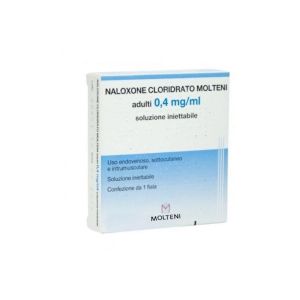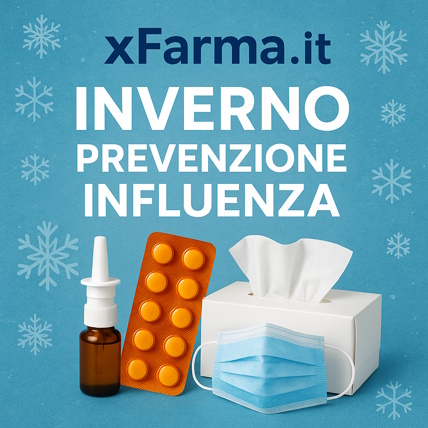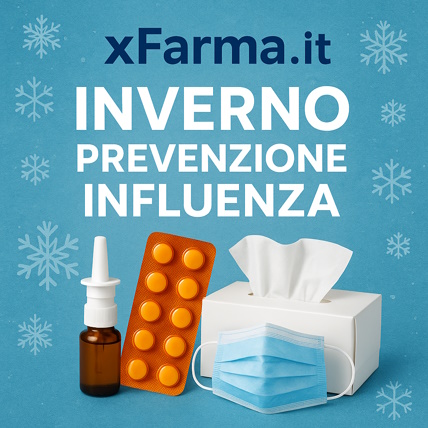Ship in Europe, Find out rates!
Language
Molteni Naloxone Hydrochloride 1 Vial 0.4mg 1ml

Regular Price
€4.29
Special Price
€3.94
-8%
Save: €0.35
In stock
Recent lowest price:
€3.86
- box Delivery in Italy in 24/48 and free returns
- star3.000+ positive reviews
- dropboxOver 60,000 products in the catalog
Manufacturer
MOLTENI & C. F.LLI ALITTI
SKU
029612013
Active principle
NALOXONE CLORIDRATO
NAME
MOLTENI NALOXONE HYDROCHLORIDE SOLUTION FOR INJECTION
PHARMACOTHERAPEUTIC CATEGORY
Opioid antagonists.
ACTIVE PRINCIPLES
Adults 0.4 mg / ml solution for injection: naloxone hydrochloride 0.4 mg. Children 0.04 mg / 2 ml solution for injection: naloxone hydrochloride 0.04 mg.
EXCIPIENTS
Water for injections.
INDICATIONS
Adults 0.4 mg / ml: antidote in the treatment of acute poisoning by narcotic analgesics. Infants 0.04 mg / 2 ml: Respiratory depression of the newborn caused by exposure of the mother to opioid substances before delivery.
CONTRAINDICATIONS / SECONDARY EFFECT
Hypersensitivity 'to the active substance or to any of the excipients.
DOSAGE
Naloxone can be administered intravenously, subcutaneously or intramuscularly. Intravenous administration, recommended in emergency situations, determines a more rapid onset of pharmacological activity. Since the duration of pharmacological effects of some drugs may exceed that of naloxone, the patient should be constantly monitored and, if necessary, the drug should be repeated. However, it is recommended to always refer the patient, as soon as possible, to an equipped emergency room. If it is necessary to dilute the solution contained in the vial, it is possible to use 0.9% sodium chloride (physiological solution) or 5% glucose. Adults. Narcotic overdose (known or suspected): The starting dose of naloxone, administered intravenously, intramuscularly or subcutaneously is 0.4 mg / ml. In the event that after intravenous administration there is not a sufficient improvement in respiratory function, it is advisable to repeat the dose at intervals of 2-3 minutes. Poor improvement after administration of 2-3 doses of the drug could be caused by any concomitant disease processes or by the presence of non-opioid drugs. Post-operative drug depression: A lower dose of naloxone is required to achieve partial or complete antagonism of the depressing effects of opioids following surgery. However, this must be established in relation to the patient's response. Naloxone should be administered intravenously, in increasing doses between 0.1 and 0.2 mg, with 2-3 minute intervals, until adequate antagonism of drug-induced depressant effects is obtained. Within 1-2 hours of the first administration, it may be necessary to repeat the administration of Naloxone, depending on the type, quantity and time interval since the last drug administration. Additional doses intramuscularly, however, determine a more 'prolonged effect. Excessive doses of naloxone can result in a significant decrease in the analgesic effect induced by the drug and increase blood pressure. Similarly, too rapid antagonism could induce nausea, vomiting, sweating or tachycardia. Children. Narcotic overdose (known or suspected): the starting dose is 0.01 mg / kg administered intravenously, intramuscularly or subcutaneously. The dose can be repeated according to the directions for administration in adults.
STORAGE
Store in the original package to protect from light.
WARNINGS
Symptoms of acute opioid intoxication are represented by respiratory depression, comatose state (precoma or alert coma and in more serious cases of deep type), pupillary miosis (absent in case of simultaneous intake of substances with mydriatic effect, in cases of acute intoxication from pethidine and in the terminal states of coma) The administration of vasopressor drugs and resuscitation techniques, such as maintaining the patency of the airways, artificial respiration and cardiac massage, can be combined to counteract acute drug poisoning. Naloxone is not effective against respiratory depression due to non-opioid drugs. The patient should be carefully observed after awakening for up to 3-6 hours in case of acute heroin intoxication and up to 24-48 hours in case of acute methadone intoxication. In fact, it is possible that respiratory depression reappears and that the patient returns to a coma after administration of the first effective dose of naloxone, because the duration of the antagonist action (20-30 minutes after intravenous administration; 2 and a half-3 hours after intramuscular administration or subcutaneous) may be lower than that of the injected opiate substance, varying from time to time (heroin, morphine, methadone, pentazocine, etc.). It may therefore be necessary to administer further doses of naloxone after the first effective administration. After the first intervention, it is therefore necessary to transfer the patient to a hospital environment for prompt treatment. Naloxone should be administered with caution to cardiac patients or those on cardiotoxic drug therapy. Naloxone should be administered with caution to patients who have experienced significant laryngospasm within the previous hours. Naloxone is used in neonates of mothers who have received an opioid substance within 4 hours of delivery and only as add-on therapy in neonates who have not been able to breathe independently after ventilation. Naloxone is not effective against respiratory depression due to non-opioid drugs. The use of naloxone in newborns of opiate-addicted mothers is not recommended, as naloxone can precipitate the withdrawal syndrome and convulsions typical of this condition in these patients.
INTERACTIONS
Naloxone must not be administered simultaneously with clonidine: the hypotensive and bradycardic effect of chronic administration of clonidine can be temporarily attenuated by intravenous administration of naloxone. Therefore it is necessary to closely monitor the blood pressure.
SIDE EFFECTS
Cardiac disorders: There have been cases of cardiac arrest, hypertension, hypotension, fibrillation and ventricular tachycardia. Skin and subcutaneous tissue disorders: sweating, hot flashes and redness. Endocrine disorders: increase in growth hormone levels when administered at doses of 0.3 to 4 mg / kg. Gastrointestinal disorders: nausea, vomiting, dysphagia. Nervous system disorders: paraesthesia, convulsions, tremors. Memory impairment for 0.3 to 4 mg / kg. Psychiatric disorders: agitation, hallucinations. Renal and urinary disorders: urge to urinate. Respiratory, thoracic and mediastinal disorders: dyspnoea, hypoxia, pulmonary edema and respiratory depression. Hyperventilation at doses of 0.3 to 4 mg / kg Report side effects directly via the national reporting system.
PREGNANCY AND BREASTFEEDING
Not relevant.
MOLTENI NALOXONE HYDROCHLORIDE SOLUTION FOR INJECTION
PHARMACOTHERAPEUTIC CATEGORY
Opioid antagonists.
ACTIVE PRINCIPLES
Adults 0.4 mg / ml solution for injection: naloxone hydrochloride 0.4 mg. Children 0.04 mg / 2 ml solution for injection: naloxone hydrochloride 0.04 mg.
EXCIPIENTS
Water for injections.
INDICATIONS
Adults 0.4 mg / ml: antidote in the treatment of acute poisoning by narcotic analgesics. Infants 0.04 mg / 2 ml: Respiratory depression of the newborn caused by exposure of the mother to opioid substances before delivery.
CONTRAINDICATIONS / SECONDARY EFFECT
Hypersensitivity 'to the active substance or to any of the excipients.
DOSAGE
Naloxone can be administered intravenously, subcutaneously or intramuscularly. Intravenous administration, recommended in emergency situations, determines a more rapid onset of pharmacological activity. Since the duration of pharmacological effects of some drugs may exceed that of naloxone, the patient should be constantly monitored and, if necessary, the drug should be repeated. However, it is recommended to always refer the patient, as soon as possible, to an equipped emergency room. If it is necessary to dilute the solution contained in the vial, it is possible to use 0.9% sodium chloride (physiological solution) or 5% glucose. Adults. Narcotic overdose (known or suspected): The starting dose of naloxone, administered intravenously, intramuscularly or subcutaneously is 0.4 mg / ml. In the event that after intravenous administration there is not a sufficient improvement in respiratory function, it is advisable to repeat the dose at intervals of 2-3 minutes. Poor improvement after administration of 2-3 doses of the drug could be caused by any concomitant disease processes or by the presence of non-opioid drugs. Post-operative drug depression: A lower dose of naloxone is required to achieve partial or complete antagonism of the depressing effects of opioids following surgery. However, this must be established in relation to the patient's response. Naloxone should be administered intravenously, in increasing doses between 0.1 and 0.2 mg, with 2-3 minute intervals, until adequate antagonism of drug-induced depressant effects is obtained. Within 1-2 hours of the first administration, it may be necessary to repeat the administration of Naloxone, depending on the type, quantity and time interval since the last drug administration. Additional doses intramuscularly, however, determine a more 'prolonged effect. Excessive doses of naloxone can result in a significant decrease in the analgesic effect induced by the drug and increase blood pressure. Similarly, too rapid antagonism could induce nausea, vomiting, sweating or tachycardia. Children. Narcotic overdose (known or suspected): the starting dose is 0.01 mg / kg administered intravenously, intramuscularly or subcutaneously. The dose can be repeated according to the directions for administration in adults.
STORAGE
Store in the original package to protect from light.
WARNINGS
Symptoms of acute opioid intoxication are represented by respiratory depression, comatose state (precoma or alert coma and in more serious cases of deep type), pupillary miosis (absent in case of simultaneous intake of substances with mydriatic effect, in cases of acute intoxication from pethidine and in the terminal states of coma) The administration of vasopressor drugs and resuscitation techniques, such as maintaining the patency of the airways, artificial respiration and cardiac massage, can be combined to counteract acute drug poisoning. Naloxone is not effective against respiratory depression due to non-opioid drugs. The patient should be carefully observed after awakening for up to 3-6 hours in case of acute heroin intoxication and up to 24-48 hours in case of acute methadone intoxication. In fact, it is possible that respiratory depression reappears and that the patient returns to a coma after administration of the first effective dose of naloxone, because the duration of the antagonist action (20-30 minutes after intravenous administration; 2 and a half-3 hours after intramuscular administration or subcutaneous) may be lower than that of the injected opiate substance, varying from time to time (heroin, morphine, methadone, pentazocine, etc.). It may therefore be necessary to administer further doses of naloxone after the first effective administration. After the first intervention, it is therefore necessary to transfer the patient to a hospital environment for prompt treatment. Naloxone should be administered with caution to cardiac patients or those on cardiotoxic drug therapy. Naloxone should be administered with caution to patients who have experienced significant laryngospasm within the previous hours. Naloxone is used in neonates of mothers who have received an opioid substance within 4 hours of delivery and only as add-on therapy in neonates who have not been able to breathe independently after ventilation. Naloxone is not effective against respiratory depression due to non-opioid drugs. The use of naloxone in newborns of opiate-addicted mothers is not recommended, as naloxone can precipitate the withdrawal syndrome and convulsions typical of this condition in these patients.
INTERACTIONS
Naloxone must not be administered simultaneously with clonidine: the hypotensive and bradycardic effect of chronic administration of clonidine can be temporarily attenuated by intravenous administration of naloxone. Therefore it is necessary to closely monitor the blood pressure.
SIDE EFFECTS
Cardiac disorders: There have been cases of cardiac arrest, hypertension, hypotension, fibrillation and ventricular tachycardia. Skin and subcutaneous tissue disorders: sweating, hot flashes and redness. Endocrine disorders: increase in growth hormone levels when administered at doses of 0.3 to 4 mg / kg. Gastrointestinal disorders: nausea, vomiting, dysphagia. Nervous system disorders: paraesthesia, convulsions, tremors. Memory impairment for 0.3 to 4 mg / kg. Psychiatric disorders: agitation, hallucinations. Renal and urinary disorders: urge to urinate. Respiratory, thoracic and mediastinal disorders: dyspnoea, hypoxia, pulmonary edema and respiratory depression. Hyperventilation at doses of 0.3 to 4 mg / kg Report side effects directly via the national reporting system.
PREGNANCY AND BREASTFEEDING
Not relevant.
| Destination | Cost | Detail |
|---|---|---|
| Italy | €5,90* | 24/72H |
| Austria, France, Germany, Slovenia | € 13* | 3 days |
| Belgium, Luxembourg, Portugal, Netherlands, Spain | € 14* | 4 days |
| Bulgary, Cechia, Hungary, Poland, Romania, Slovakia | € 19* | 5 days |
| Denmark, Estonia, Finland, Ireland, Lithuania, Latvia ,Sweden | € 22* | 5 days |
| United Kingdom, Switzerland, Greece, Malta/td> | € 30* | 7 days |
| Canada | € 40 | 7 Days |
European shipments with express courier: FedEx, MBE, DHL
*For the shipment outside band B ther's an extra cost of 22€ *For the shipment outside band C ther's an extra cost of 30€ Delivery Times exclude Saturday and Holidays
For Islands and Areas of difficult Accessibility the shipments are made in 72 hours and the cost will be increased by 15€
The images of the products shown on our site are purely indicative and may differ in shape, color, text and packaging shown on them. Given the difficulty of updating all the products on our site in real time or any errors, XFarma.it, all products will be identified through SKU MINSAN (code of the Ministry of Health).

